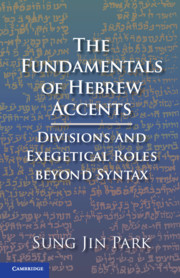Book contents
- The Fundamentals of Hebrew Accents
- The Fundamentals of Hebrew Accents
- Copyright page
- Dedication
- Contents
- Tables
- Preface
- Abbreviations
- 1 Introduction to Tiberian Hebrew Accents
- 2 Major Rules of Hebrew Accents
- 3 Substitutions of Disjunctive Accents (I)
- 4 Substitutions of Disjunctive Accents (II)
- 5 Conjunctive Accents
- 6 Minor Rules of Hebrew Accents
- 7 The Divisions by Hebrew Accents
- 8 The Exegetical Roles of the Divisions
- Book part
- Bibliography
- Subject Index
- Scripture Index
6 - Minor Rules of Hebrew Accents
Published online by Cambridge University Press: 27 June 2020
- The Fundamentals of Hebrew Accents
- The Fundamentals of Hebrew Accents
- Copyright page
- Dedication
- Contents
- Tables
- Preface
- Abbreviations
- 1 Introduction to Tiberian Hebrew Accents
- 2 Major Rules of Hebrew Accents
- 3 Substitutions of Disjunctive Accents (I)
- 4 Substitutions of Disjunctive Accents (II)
- 5 Conjunctive Accents
- 6 Minor Rules of Hebrew Accents
- 7 The Divisions by Hebrew Accents
- 8 The Exegetical Roles of the Divisions
- Book part
- Bibliography
- Subject Index
- Scripture Index
Summary
Chapter Six examines several minor rules of Hebrew accents that are mainly related to deviations from the basic subdivison unit and stress crash. The simplification and division rules (deviations from the basic subdivision unit), the spirantization (sandhi) rule, and the nesiga rule (stress crash) are investigated. The simplification process usually occurs under three conditions: 1) when the disjunctive accent is a final disjunctive that may be replaced by a conjunctive, 2) when the domain of that final disjunctive consists of two words, and 3) when the final disjunctive immediately precedes its greater terminal disjunctive accents. The division process is in fact the opposite of the simplification process. A unit of two words with disjunctive accents results from a division process in which a disjunctive accent appears in place of a conjunctive accent. If a vowel-final word carries a disjunctive accent, spirantization does not occur because that disjunctive functions as a separator. However, if a vowel-end word carries a conjunctive accent, spirantization does occur. The nesiga rule is to retract the main stress on the first word when two accents appear adjacently.
Keywords
- Type
- Chapter
- Information
- The Fundamentals of Hebrew AccentsDivisions and Exegetical Roles beyond Syntax, pp. 73 - 92Publisher: Cambridge University PressPrint publication year: 2020



